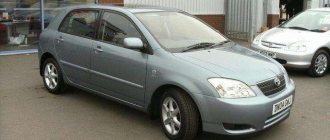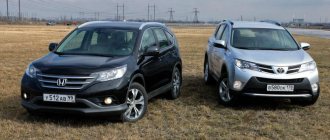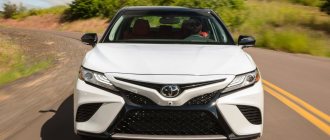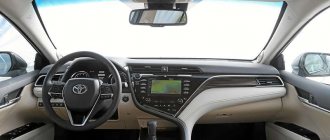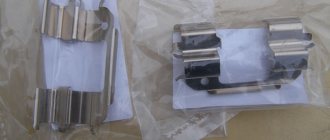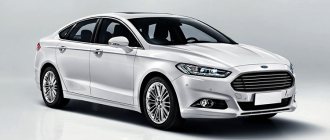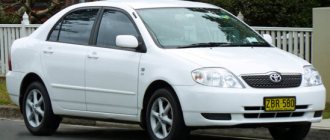Both the Hyundai Elantra and the Toyota Corolla are rightfully considered good-quality and reliable cars with approximately the same price. Car dealers really like these cars because they bring good income and sell quickly and easily, not only in Russia, but all over the world. But our situation is a little different. Some time ago, there were much more sedans belonging to the golf class.
Hyundai Elantra 2020
Now the situation has changed: class C has begun to be crowded out by more compact and budget sedans and crossovers of class B. The new Volkswagen Jetta and Mazda 3 are not yet available. The Sentra and Renault Fluence were discontinued. The extremely popular Ford Focus has left the market, along with the automaker itself. And before that, Chevrolet left with its Cruze and Opel Astra. Only the modernized Elantra remains as a worthy rival to the new Toyota Corolla. Both models come with naturally aspirated engines, only the first is equipped with a 6-speed automatic transmission, and the second with a continuously variable transmission. The previous Japanese woman failed to beat the Korean woman; on the contrary, she was inferior to her, in some respects quite significantly. Hyundai Elantra or Toyota Corolla, which is better this time?
Comparison of technical characteristics
Both sedans belong to the same class. However, they have similar technical characteristics, including ground clearance (150 mm) and trunk sizes (the Elantra has 6 liters more). However, cars have slightly different target audiences. Thus, Elantra is of interest to people with incomes below the average, while Toyota claims to interest the middle class that is practically absent in the Russian Federation.
So, the Elantra and Corolla have identical body lengths and are 4620 mm. The width of the Japanese and Korean are almost the same. The Corolla is 1.5 cm taller. At the same time, it has significantly less space in the cabin due to its design features. The wheelbase of the cars is the same and equal to 2700 mm.
In terms of weight, the Korean car is 75 kg heavier than its competitor. Its curb weight is 1300 kg, while the Corolla has 1225 kg. It turns out that with the same dimensions, a car from Hyundai is much more interesting to the buyer who has decided on the format of the car, since it is at least 120 thousand cheaper.
Start of production
The Korean car Hyundai Elantra has a fairly long history; production of this model began back in 1990.
At first, passenger cars were sold in some European countries and in Australia under the name Lantra, but due to claims from other companies that had cars with similar consonant names, the brand was renamed Elantra in 2001.
Over the years of the model’s existence, six generations have changed; the Hyundai Elantra-6 has been produced since 2021; in Russia, assembly has been carried out since the beginning of the summer of 2016 in Kaliningrad. In June of this year, the new Hyundai Elantra was presented in Moscow.
Engines and transmission
The current Hyundai Elantra belongs to the sixth generation and appeared on the Russian market three years ago. Not long ago a restyled modification was released. It is assembled at the Kaliningrad plant from large vehicle kits. It is equipped with 1.6 and 2 liter petrol engines, developing 128 and 150 horsepower, 155 and 178 Nm of torque, respectively. The engine is paired with a six-speed automatic transmission. The car has front-wheel drive. The acceleration time of the Elantra with the first engine is 11.6 seconds; in the second case, the car reaches the first hundred much faster.
The Toyota Corolla present on the market belongs to the 11th generation. She debuted just recently. Available in a sedan version with a 1.6 liter engine. Assembled at the Turkish Toyota plant. The engine develops 122 horsepower and 157 Nm of torque. It is paired with a continuously variable transmission. The car has front-wheel drive. Acceleration time to 100 km/h is 10.5 seconds.
general information
All-wheel drive is a system where torque is distributed to all four wheels of the vehicle. This is more beneficial when driving a car in some cases, since this system provides increased traction in difficult weather conditions and is most suitable for off-road use.
This allows all four wheels to move up and down independently, providing a smooth ride when you're driving over bumps in the road, for example.
The additional warranty covers vehicle parts such as the engine, transmission, driveshaft, etc. It usually lasts longer than the basic warranty. It lasts either a certain number of years or the number of kilometers traveled.
A basic vehicle warranty covers everything except parts that are subject to normal wear and tear, such as windshield wipers and brake pads. It lasts either a certain number of years or the number of kilometers traveled.
The gasoline engine offers several advantages over the diesel engine. For example, gasoline engines tend to be lighter and cheaper than their diesel counterparts. Gasoline engines also tend to have more power and fuel is more readily available.
A basic vehicle warranty covers everything except parts that are subject to normal wear and tear, such as windshield wipers and brake pads. It lasts either a certain number of years or the number of kilometers traveled.
The turning radius indicates the smallest circular turn a car can make. With a smaller turning radius, it's easier to complete a U-turn in one try instead of having to turn the car back and forth to make a U-turn.
Front-wheel drive is the most common type of transmission and has several advantages. It costs less to produce (lowering the cost of the vehicle) and is also lighter, which helps save fuel. Positioning the engine above the drive wheels also helps increase traction.
The additional warranty covers vehicle parts such as the engine, transmission, driveshaft, etc. It usually lasts longer than the basic warranty. It lasts either a certain number of years or the number of kilometers traveled.
Ride quality, maneuverability and handling
The Corolla and Elantra can accelerate at the same speed by a good four. Both from a standstill and in motion they stand up to each other. However, picking up speed is still more pleasant in a Hyundai car. The six-speed automatic transmission is perfectly matched to the engine and always engages the most appropriate gear.
The Toyota model behaves well only when driving with the throttle half open. As soon as you press it down, the engine begins to squeal like a hunted animal. All harmony comes to naught, and revs do not bring joy, as on the Elantra. Switching to sport mode does not help - the variator is “stupid”. The only benefit from this is the possibility of engine braking. At the same time, the consumption of the cars is approximately the same - 7.5 liters per 100 km. However, Toyota runs on 92 gasoline.
The downside when driving a Hyundai Elantra is the sound insulation, or rather, some of its shortcomings. You can hear the roar from the road and pebbles knocking on the wheel arches. The Toyota product is noticeably quieter. Ride comfort is its strong point. And even on broken asphalt it rides quite smoothly. The suspension behaves extremely efficiently, silently filtering out all the potholes. However, the version adapted for Russian roads with retuned shock absorbers and springs gives a swing like on the waves. In these cases, even a breakdown of the suspension is possible. The current Corolla is not afraid of turns. The driver is helped by a clear steering wheel and an excellent multi-link design that plays well when lifting the gas pedal. The competitors have a simple twisting beam.
The Elantra has a tightly packed suspension. It is also very good in energy consumption. There is no breakdown even when hitting deep holes or speed bumps. This car has no sway. The suspension is perfectly adapted to Russian roads. Elantra is also able to please the driver who loves active driving. It corners beautifully and feels confident when moving around an arc, while its steering wheel gives you a pleasant feeling of effort. However, if you enter a corner at high speed, the Hyundai begins to “float” outward. The Toyota model is more stable in this regard.
Comparison of characteristics for basic configurations
| Characteristics | Hyundai Elantra (1.6 MT Start) | Toyota Corolla (1.6 MT Standard) |
| Drive unit | Front | Front |
| Body type | Sedan | Sedan |
| Transmission | Mechanics (6) | Mechanics (6) |
| Engine volume, l | 1.59 | 1.6 |
| Acceleration to 100 km/h, sec | 10.1 | 11 |
| Ground clearance, cm | 15 | 15 |
| Max. speed, km/h | 200 | 195 |
| Length, cm | 462 | 463 |
| Width, cm | 180 | 463 |
| Height, cm | 145 | 463 |
| Total seats | 5 | 5 |
| Weight, tons | 1.3 | 1.37 |
| Max. power, hp | 128 at 6300 rpm. | 122 at 6050 rpm. |
| Max. torque, N*m | 155 at 4850 rpm. | 153 at 5200 rpm. |
| Type of power plant (motor) | In-line, 4-cylinder | In-line, 4-cylinder |
| Fuel | Petrol | AI-95 |
| Supercharger | No | No |
| Consumption per 100 km in the urban cycle, l. | 8.7 | 8.7 |
| Consumption per 100 km in the extra-urban cycle, l. | 5.2 | 5.4 |
Chassis
The Toyota Corolla has a chassis that immediately discourages the desire to perform feats and does not fit in with the driver-racer. But the Toyota Corolla rolls evenly and equally comfortably both on smooth asphalt and over bumps. The suspension looks soft, but oddly enough, it is not afraid of even large potholes the size of half the wheels and does an excellent job of combating roll, which is inevitable when changing lanes in sharp turns.
Hyundai Elantra car trunk
As for turns, the Toyota Corolla navigates them very carefully, as befits a respectable Japanese. But on the other hand, it clearly demonstrates that the chassis, assembled from inexpensive elements, lends itself well to training.
The Toyota Corolla engine matches the chassis. Again, a power unit of 140 horses clearly cannot be called a weapon for rapid and dizzying attacks, but for long trips alone or with company, the engine is clearly in place. In addition, the engine is not noisy, only occasionally snapping at the persistent pressure of the accelerator pedal. By the way, such inappropriate driver behavior also unnerves the variator. After all, sharp and strong blows on the pedals can throw the gearbox into a kind of stupor.
The traditional automatic transmission of the Hyundai Elantra is much preferable for city driving. Tolerating any rudeness, without wasting time on reflection, the Korean’s automatic transmission continues to shift gears perfectly. If you loosen your grip a little, the switching will become more gentle and smooth.
The Hyundai Elantra generally drives more cheerfully than the Toyota. After all, besides the quick and savvy box, there are other reasons for such a conclusion. Firstly, the Hyundai engine is 10 horsepower more powerful, and secondly, the Korean has a more elastic suspension.
It is this same suspension that affects the smoothness of the ride, which cannot be called ideal only because the shock absorbers are a little hard.
But the Korean seems to have studied our Russian pits in advance and knows how to deal with them. The passengers and driver do not lose their knees when cornering, and in this regard, Hyundai is probably more talented than its rival in the Corolla. But everything is done too judiciously, without a spark, or something. But this is how ordinary cars are supposed to be, although not the most affordable, if you look at it from the point of view of an ordinary person who lives in Russia.
Trunk of a Toyota Corolla
Comparison of configurations and prices
The previous generation of Toyota Corolla was hardly more expensive than today's competitors. Even with a 1.8-liter engine, it cost no more than one and a half million. The current modification, even in the starting configuration, costs more than 120 thousand more than the basic versions of its rivals. The flagship Corolla is valued at more than 1.7 million rubles. At the same time, the engine is now much more modest. It has a volume of only 1.6 liters. And for that amount you can already take a closer look at other sedans, for example, the Optima from Kia, the 6th model of Mazda and even the Toyota Camry. And competitors are more than 200 thousand cheaper. Moreover, they are equipped with more powerful power units.
However, there is no need to rush to conclusions. The flagship version of the Corolla has truly top-end equipment. There's a head-up display, a large 7-inch in-dash color display, adaptive cruise control and lane keeping assist. Of course, you can do without this, and this will reduce the price to 1.58 million rubles. And if you also abandon 17‑inch wheels, head optics built on LEDs, leather interior trim, wireless charging for smartphones, keyless entry and engine start, then you can completely meet the amount of 1.434 million rubles. In this case, the car will not remain “naked”. It will have alloy wheels, good climate control, an 8-inch touchscreen multimedia system, a rearview camera and heated all seats, steering wheel and windows.
But this is just an approximation to the Elantra in the maximum configuration, which with all the bells and whistles costs only 11 thousand rubles more. In this modification, it is equipped with a naturally aspirated 2-liter engine, LED headlights, induction charging for smartphones, leather interior, and even an electrically adjustable driver's seat with memory positions. And this is not to mention the presence of alloy wheels, climate control, a multimedia system with a 7-inch diagonal touch screen, a heated steering wheel and all seats. By the way, all this, starting with the wheels, is available in a simpler version with a 1.6-liter engine for only 1.22 million rubles.
Practicality and convenience
The cargo capabilities of the rivals are approximately equal: the trunk volume according to the VDA method for the Elantra is 460 liters, for the Corolla – 450. The rear seat backs fold in a ratio of 2:3 and “fall” onto the cushions, forming an uncomfortable step with the trunk floor. The opening of the embrasure is a little larger in Toyota, but Hyundai compensates for this omission with a more practical placement of the rear audio system speakers: in the Elantra they are nested in the rear doors and do not disturb anyone, and in the Corolla they are built into the shelf behind the rear seats, protruding with their unprotected back side into the trunk. When handling some large and hooked load like skis in the cargo compartment, you can easily hit the speakers and, what good, damage them. In general, the Corolla developers should cover up this “music” with something, but otherwise everything is fine, no worse than that of its rival. Parity.
Maintenance costs
Calculating the cost of servicing a Hyundai Elantra or Toyota Corolla, i.e. comparison of taxes, insurance prices, gasoline, etc. lead to approximately the same amounts from 15 to 17 rubles per kilometer.
Hyundai Elantra configurations and prices
| Equipment | Engine | Volume, l | Power, hp | checkpoint | Drive unit | Acceleration to 100 km/h, c. | Max. speed, km/h | Consumption per 100 km, l | Price, rub. |
| 1.6MT Active | petrol | 1.59 | 128 | Mechanics | front | 10.1 | 200 | 8.6 / 5.1 / 5.9 | 1 191 000 |
| 1.6MT Base | petrol | 1.59 | 128 | Mechanics | front | 10.1 | 200 | 8.6 / 5.1 / 5.9 | 1 121 000 |
| 1.6MT Start | petrol | 1.59 | 128 | Mechanics | front | 10.1 | 200 | 8.6 / 5.1 / 5.9 | 1 050 000 |
| 1.6 AT Active | petrol | 1.59 | 128 | machine | front | 11.6 | 195 | 9 / 5.2 / 5.9 | 1 226 000 |
| 1.6 AT Base | petrol | 1.59 | 128 | machine | front | 11.6 | 195 | 9 / 5.2 / 5.9 | 1 156 000 |
| 2.0MT Active | petrol | 2 | 150 | Mechanics | front | 8.8 | 205 | 9.5 / 5.3 / 6.9 | 1 221 000 |
| 2.0 AT Active | petrol | 2 | 150 | machine | front | 9.9 | 203 | 10.1 / 5.6 / 6.9 | 1 256 000 |
| 2.0 AT Elegance | petrol | 2 | 150 | machine | front | 9.9 | 203 | 10.1 / 5.6 / 6.9 | 1 316 000 |
Toyota Corolla configurations and prices
| Equipment | Engine | Volume, l | Power, hp | checkpoint | Drive unit | Acceleration to 100 km/h, c. | Max. speed, km/h | Consumption per 100 km, l | Price, rub. |
| 1.6 MT Classic | petrol | 1.6 | 122 | Mechanics | front | 11 | 195 | 8.6 / 5.3 / 5.9 | 1 262 000 |
| 1.6 MT Standard | petrol | 1.6 | 122 | Mechanics | front | 11 | 195 | 8.6 / 5.3 / 5.9 | 1 174 000 |
| 1.6 CVT Classic | petrol | 1.6 | 122 | CVT | front | 10.8 | 185 | 8.1 / 5.2 / 5.9 | 1 319 000 |
| 1.6 CVT Comfort | petrol | 1.6 | 122 | CVT | front | 10.8 | 185 | 8.1 / 5.2 / 5.9 | 1 435 000 |
| 1.6 CVT Prestige | petrol | 1.6 | 122 | CVT | front | 10.8 | 185 | 8.1 / 5.2 / 5.9 | 1 581 000 |
| 1.6 CVT Prestige Safety | petrol | 1.6 | 122 | CVT | front | 10.8 | 185 | 8.1 / 5.2 / 5.9 | 1 701 000 |
* — information on prices is for reference only. Check with your local dealer for exact pricing.
Who is the main consumer?
One of the studies claims that Hyundai Solaris is one of the most popular among taxi drivers. This means that the mechanism is affordable, very durable, and has relatively low fuel consumption. It is also suitable for people of status, businessmen or bosses in large companies, and of course, for most other car enthusiasts.
In turn, the Toyota Corolla is not intended for racing or off-road driving. This mechanism is suitable for many drivers who prefer quiet, comfortable movement; its cost is quite affordable, and the build quality is very high.
Appearance, dimensions
Looking at the car from the outside, it immediately becomes clear that the Corolla is made to last, and what else can you expect from a Japanese manufacturer. Toyota has quite strict lines, but for some reason they do not evoke an emotional response, like earlier versions. But the Korean car is really pleasing in this regard. Somehow it's more pleasing to the eye. The body finishing is excellent and looks much more interesting.
The overall dimensions of the Elantra and Corolla are: 4570/1775/1450 mm and 4620/1775/1465 mm. The wheelbase is 2700 mm. The ground clearance is the same and is 150 mm. From the dimensions it is clear that the cars have the same height, but the Corolla is 7 cm longer in length and 1.5 cm in height.
General points
The brands are similar in many ways. Common features can be seen in the following:
- Included in the same price category.
- They use gasoline to operate.
- They have a sedan-style body.
- Equipped with the same gearbox.
- These are all-wheel drive models.
- They have an attractive appearance.
- They have approximately the same engine volume and power.
- These are four-door cars.
- They have a spacious compartment for storing luggage.
- They are characterized by a spacious interior and can accommodate the same number of people.
- Their wheelbase is identical.
- Economical in terms of fuel consumption.
- They have many positive reviews from motorists.
Salon and trunk
The Japanese model is much tighter than its rival due to the fact that its ceiling is too low. However, overall the Corolla's interior makes a pleasant impression. The main decoration of the interior is the front panel, made in several tiers, above which rises a large touch screen of the multimedia system. When the car was presented in Europe, auto experts noted the hard plastic door trim. However, in the Russian modification this defect was corrected - now it is soft everywhere. The Corolla's interior looks richer than the Elantra's. It is immediately clear that the car has undergone a serious restyling, and not a light update.
However, where would we be without a “fly in the ointment”. The handbrake and variator selector, as well as the center armrest cover, have play. In addition, closing the doors requires a fair amount of force. The Corolla lacks the integrity that was present in the models of the nineties of the last century. This undermines faith in the impeccability of Toyota quality. After all, those models seemed made to last. Which, however, is partly confirmed by the fact that they still drive, and sometimes better than new cars.
But the updated Elantra was very pleasing. It is assembled very high quality. However, the finishing materials themselves leave much to be desired. They are too simple. Here Hyundai is inferior not only to Toyota, but also to other competitors. The window sills look especially sad, as their hardness resembles stone. And even a two-tone finish doesn’t help here. And for some reason the side mirrors glare, reflecting the silvery ribs of the outer air deflectors on the front panel.
But overall, the Elantra's interior is very pleasant. A well-designed driver's seat embraces the body and has a wide range of adjustments. It will be comfortable for a driver of any height and weight. The other seats differ little from the driver's. Of course, as usual, they are simpler at the back, but they are also very comfortable. The multimedia system has a convenient and understandable menu. In addition, the Elantra's interior is equipped with eyeglasses, and the image coming from the rear view camera is complemented by a dynamic line that helps the driver. Car wipers perfectly clean the windshield, leaving a minimum of dirty area. The luggage compartment of the rivals is approximately the same: 458 and 452 liters.
Grade
If we evaluate the purchase of these cars from the point of view of experts, then again, they consider, citing the Russian market as an example, not the most productive idea. For almost the same price you can buy a more versatile vehicle, for example, a crossover. But a golf-class sedan is just a sedan, which gives the driver a completely different comfort.
As for the assessment of the two models presented above, again, left by experts, they agree that the Japanese car is still better. Not so much, but it has a cooler image, which will ultimately determine the price on the secondary market.
Let's list the pros and cons of both models:
Advantages of Hyundai Elantra:
- A trunk where you can safely transport a couple of travel suitcases
- Plenty of space in the glove compartment
- The Korean camera display has targeting markings, although it does not predict the trajectory of movement when turning the steering wheel
- The seats have the correct profile and grippy non-staining upholstery
- Flat floor at the rear, allowing three passengers to sit comfortably
- Optonic tidy, although only adorning the expensive version
- Automatic transmission, which is Hyundai's own development
The video checks the suspension of a Hyundai Elantra:
Advantages of Toyota Corolla:
- The trunk is more voluminous and convenient than that of a Hyundai
- The seats and driver's seat look much more attractive
- Rear view camera, parking sensors and assistant
- Convenient plastic cover that covers the socket, multimedia system connectors and much more
- All-round digitization of instruments
- CVT that can save gasoline
Cons of Hyundai Elantra:
- Clearly a budget look for the interior of inexpensive versions
- Small trunk
- Lack of trunk lock
Cons of Toyota Corolla:
- Small wheels
- Riding that can't be called aggressive
- CVT that can go into a stupor
- Small trunk
The following conclusion can be drawn. Both in terms of statics and dynamics, the Korean car outperforms the Japanese. The Corolla clearly has lower build quality and a weaker engine, while the Korean has good brakes, the car has excellent directional stability and is highly comfortable. But the Korean loses in the volume and convenience of the trunk, as well as in other parameters. If we evaluate on a five-point system, then we give Toyota Corolla 4, and Hyundai Elantra 5.
Which is better to choose? (pros and cons of one and the other)
The Elantra's front seats lack lumbar support, and the Corolla's headrests are too hard. The visibility in both cars is approximately the same. Of course, in terms of interior equipment, the Corolla wins: there is a projector and cruise control. Our competitors don't have this yet. The interior decoration is generally beyond praise. Elantra definitely loses here. But in terms of interior space, the Korean car is much better. Toyota's low ceiling negates all the charms of its interior.
In terms of driving performance, the Hyundai product is better. The dynamics of the cars are approximately the same. In terms of handling, the Elantra is slightly better, especially when cornering. By the way, Toyota has a slightly higher ground clearance, and this despite the presence of a metal crankcase protection.
In terms of comfort, the Corolla is quieter. The cabin becomes noisy only at maximum acceleration. The Elantra has rather weak sound insulation of the wheel arches. The cars are approximately the same in terms of ride smoothness. The Corolla's climate system has the best characteristics; it has heating for everything you need.
The vastness of the Korean auto giant's dealer network is pleasantly impressive, as is the service mileage. But Toyota runs on 92 gasoline. The Elantra is still slightly inferior to the Toyota, although it leaves a very pleasant impression. It has a very spacious interior, a large selection of trim levels and an energy-intensive suspension. Its main trump card is the price. As already mentioned - 1.22 million rubles and you can take the car!
But Toyota is better equipped this time. Now it is a very modern car with advanced equipment, excellent interior architecture, a high level of comfort and good handling. So, if you have some extra money in your pocket, you can go shopping.
In the city
Let's start with the fact that both cars are quite large. Yes, formally they belong to the so-called compact class, but with their dimensions you can’t count on easy parking or any special maneuverability in urban conditions. There are no problems with visibility: the exterior mirrors on both cars are quite large, the A-pillars are located well and are not an eyesore, the rear windows are wide, but “fit” entirely into the frame of the interior mirror.
The acceleration dynamics of the Corolla impresses a driver not experienced in supercars: the engine roars sportily at high speeds, the “robot” changes gears with noticeable jerks, and the car quickly picks up speed. But this is in the sports “robot” mode; in the normal Corolla it accelerates more slowly, but without jerking. The most serious drawback of the “robot” was revealed on the climbs: while on flat overpasses it can move off smoothly even more or less, then it storms steep hills like a hopeless “teapot” - it burns the clutch, rolls back, groans and jerks. And nothing can be done about it: the way the developers configured this “cyborg” is how it serves – residents of mountainous areas should think ten times before ordering a Corolla with manual transmission. Toyota's steering in the city seems a bit heavy - in order to turn around with a minimum radius, you have to turn the steering wheel with both hands. In this case, it would be logical to expect good information content from the steering wheel, and indeed there is, but it is somehow artificial, and with increasing speed, the resistance of the mechanism increases stepwise, which, if unaccustomed to it, can frighten the driver.
The electric power steering on the Elantra is more efficient - even when parked, the steering wheel can be turned with one finger. However, with increasing speed, this lightness, unfortunately, almost does not disappear; the feedback is weak and gives rise to a feeling of uncertainty in the car. In terms of acceleration dynamics, the Elantra with automatic transmission, contrary to the figures stated by the factory, is inferior to the robotic Corolla, but the “automatic” pleases with the smoothness of switching.
Versions with “mechanics” pleasantly surprise with the clarity of the gear shift mechanism and faster acceleration, but are disappointing with the long-travel clutch pedal that grabs at the very top.
In the grip of a metropolis, a common drawback of duelists is the complete lack of protective body moldings. Without them, of course, the cars look very elegant, but the slightest contact with solid bodies leaves scratches and abrasions on their bodies - those who insure their car with comprehensive insurance are doomed to regular calls to the traffic police with the subsequent recording of “beatings” and other bureaucratic ordeals.
In general, during city use, the Elantra left a more pleasant impression: easy control and an “honest” automatic transmission are better combined with the jagged rhythm of traffic lights and cramped lanes than the sporty sharpness of the “robot” and the artificial resistance of the steering wheel in the Corolla.
Video
Comparison of basic configurations
| Function | Hyundai Elantra (1.6 MT Start) | Toyota Corolla (1.6 MT Standard) |
| EUR (steering) | ✔ | ✔ |
| Hill Start Assist Control (HAC) | ✔ | ✔ |
| Heated side mirrors | ✔ | ✔ |
| LED daytime running lights | No | ✔ |
| Leather interior | No | No |
| central locking | ✔ | ✔ |
| Heated 1st row of seats, electric | ✔ | ✔ |
| Electronic Brake Force Distribution (EBD) | ✔ | ✔ |
| Keyless entry into the car | No | No |
| Front-camera | No | No |
| Heated 2nd row seats | No | No |
| Anti-lock system (ABS) | ✔ | ✔ |
| Climate control (climate control) | No | No |
| Color display of multimedia system | No | No |
| Driver's seat drive, electric | No | No |
| Steering column, adjustable | ✔ | ✔ |
| Front parking sensors | No | No |
| Power steering (steering) | No | No |
| Rear parking sensors | No | No |
| Cruise control | ✔ | No |
| Stability Control (ESP) | ✔ | ✔ |
| LED rear lights | No | ✔ |
| Blind Spot Monitoring System | No | No |
| LED headlights | No | No |
Author: Alexey Podshivalov


